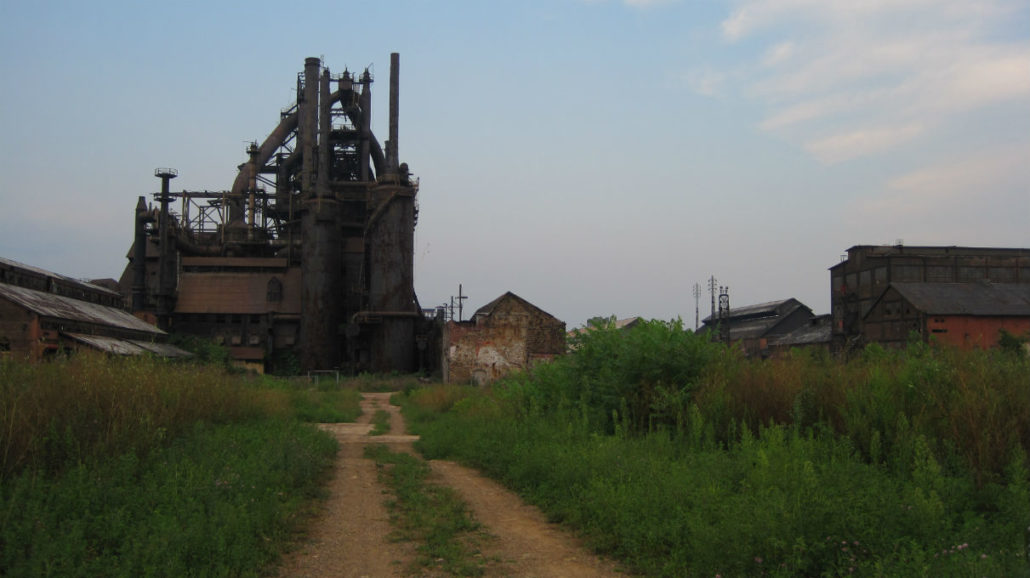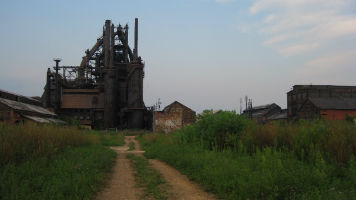
BETHLEHEM, Pa. (AP) – What enchants painter Rachel Lussier about the Bethlehem Steel’s old blast furnaces is the “beautiful decay” – the warm rust colors and, when the sunlight is just right, iridescent grays wrapped around what was once the plant’s fiery belly.
The image takes shape on the oil painter’s canvas just feet away from the furnaces the Steel left behind after it closed its hometown plant in Bethlehem two decades ago. The painting focuses tightly on the large cylindrical shape that spans the length of the industrial spires.
To replicate the pipe’s color, Lussier mixes a bit of red with black, white and blue, holds her brush up to the sunlight and compares the color to the furnaces. She adds more blue.
Proximity is important to Lussier. The 50-year-old painter traveled from her home in Stamford, Conn., in September to spend nearly three weeks painting the furnaces from life rather than a photograph.
“There are a lot of physical challenges up here. I have to lug a lot of stuff up. It’s hot. Sometimes, the bees are all over. It’s not a like being in a studio, but when you get out of your comfort zone, that’s when you grow,” Lussier says. “It’s just me and the canvas. You have to deal with the elements, and sometimes that propels you forward.”
She is part of a niche of artists who work en plein air. It’s French term for in the open air, a method immortalized by the 19th Impressionist painters like Monet and Renoir.
Lussier doesn’t paint poppies or parasols, but the mechanical muscle of the Industrial Revolution. She’s painted a B-29 and a gas pump. Her portfolio features tight images of industrial gears, hoses and tiny nuts that hold the machines together.
The images contrast with other plein artists who showcase the natural beauty of the Rocky Mountains in the west to the architectural detail of Central Moravian Church’s Bell Tower in Bethlehem. The artwork can range from abstract to figurative.
What binds plein air artists is not the subject or form but the practice: working outdoors with real subjects. But even that can be subject to interpretation by artists as to whether finishing touches can be applied in the studio.
Bruno Baran, chairman of the Mid-Atlantic Plein Air Painters Association, is a purist – and only counts artwork that is completed outdoors.
He says he believes interest in the age-old practice has been re-energized in the last decade, perhaps part of a push to make art more accessible to the public. Plein air artwork, he said, often portrays familiar places, something with which people can connect.
His organization, more than 400 painters strong, regularly participates in paint-outs up and down the East Coast. The artwork generated in a weekend, he said, can raise upward of $100,000.
In Pennsylvania, he said he knows of at least five annual juried plein air competitions, including one in Bucks County. A plein air competition was held last month at the Riverside Festival of the Arts in Easton.
There are regular opportunities for artists – novices and veterans – to meet and paint outdoors in the Lehigh Valley. Historic Bethlehem Museums and Sites has hosted plein air classes at its properties. And the 70-year-old Bethlehem Palette Club has regularly organizes paint-outs in the Lehigh Valley, including at the SteelStacks arts and cultural campus which opened six years ago at the foot of the blast furnaces at the former Bethlehem Steel plant. He says artists savor the close-up views of old industrial structures that still stand.
“The blast furnaces seem to be very popular,” says Ben Gilmore, Bethlehem Palette Club’s director of paint-outs. “I think it’s the size that draws people to them.”
Stacie Brennan, senior director for visual arts at ArtsQuest, said she often sees artists with their easels around SteelStacks, but Lussier’s three-week commitment takes it to another level. Brennan says she hopes to have Lussier back for an exhibition of her finished pieces.
“It’s exciting to see artists who are inspired by the Steel and take this opportunity to not only create their work here but also get to know the culture and history through the people they come in contact with on a daily basis,” Brennan says. “It’s a very intense process to watch.”
Some of Steel’s old buildings and what’s left inside them are almost “sculptural” in terms of symmetry and are washed in a beautiful palette of rusted colors, said Tony Hanna, director of the Bethlehem Redevelopment Authority, which owns the trestle.
“Rachel is the kind of artist who can capture that,” Hanna says. “She paints in small components, drilling down to a pipe or a piece of machinery.”
Educated in the fine arts in New York City and Italy, Lussier was trained in figurative art and built a career in the art world. In 2000, she left her position as senior art director at Sotheby’s where she designed marketing material catalogs and exhibitions for the sales of world-renowned collections.
Finding studios restrictive, she wanted to remove herself from the tangle of computers and keyboards and get into communities to study the machines that propelled the nation into a world power.
Without the aid of photographs or the amenities of a studio, Lussier says she wants nothing to come between her subject and the canvas.
She likens the practice to recording a song live on location as opposed to inside a studio. She says studio recordings can be touched up and perfected, but live recordings are spontaneous and highlight the level of musicianship, she says.
Working outdoors, though, can be grueling. She must deal with fickle light and weather. On some sites, like the Steel, she must haul her supplies up to the Hoover-Mason Trestle, the elevated walking path that once carried raw materials to the furnaces and now allows people to get a close look at the old furnaces.
Working en plein air, especially in Bethlehem, requires quite a bit of stamina.
A runner since childhood (she carried the Olympic torch in 1984 for a stretch through her native state of Michigan), Lussier says she understands how to pace herself. She’s regimented, painting for six hours a day under the sun beating down on the trestle, which is suspended 46 feet off the ground.
To break up the monotony, she puts on earbuds and listens to jazz, blues or, if she is really dragging, punk rock.
She dresses for the job – no painter’s smock. Just a white tank top, gray pants, baseball cap and, sometimes, a pale pink button-down shirt to protect her from the sun beating down on the trestle.
From the public plazas below, Lussier’s petite frame nearly gets lost in the towering furnaces that rise more than 200 feet high at SteelStacks.
Bethlehem’s industrial landscape, Lussier finds, is an enigma – bones of dead machines popping behind the vibrant cultural venues that have grown around it. The interaction with the community, she says, has helped her capture the Steel on canvas.
She said she finds that people are as curious about how the art is created as the finished work. Many of those who stop by to admire her work, she notes, are people who may not visit an art museum. She said she relishes the chance to talk about her work to people who likely will never see it finished.
She has met some of those in the Asian community who arrive daily at the Sands Casino on buses from New York City and take strolls on the trestle. There is a language barrier, she says, but some days, a few gaze over her canvas as she works and one of the men gave her the thumbs-up sign.
In some ways, Lussier muses, art is a universal language.
Other days, retired steelworkers stroll by, pointing out details on the machinery and telling her what it was like to work at the Steel. She hears stories of how the plant provided good jobs to raise families. She hears about the caustic industrial environment and warm camaraderie among lifelong coworkers.
“That’s what I’m chewing on here: what is our relationship to industry,” Lussier says. “There are good and bad sides. I think that’s really what I’m examining.”
___
By NICOLE RADZIEVICH, The (Allentown) Morning Call
Copyright 2017 Associated Press. All rights reserved. This material may not be published, broadcast, rewritten, or redistributed.
AP-WF-10-14-17 0705GMT


